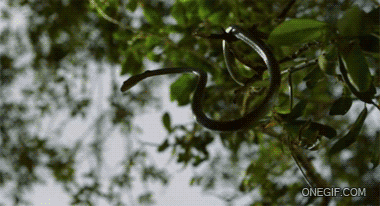Flying Tree Snake
(Chrysopelea spp.)
(Chrysopelea spp.)
If you are lucky, you may spot this elegant snake warming itself quietly in a sunny spot at Sungei Buloh Nature Park. But you have to be sharp eyed as they are well camouflaged.
They are the largest of the Flying Snakes, so named because they are the only snakes that can move through the air. They don't actually fly or glide but instead, perform a sort of parachute jump.
Soaring Serpents: To do this, they "suck in their guts" to form a U-shaped half-cylinder along the entire length of their bodies. The outer edges of their belly scales are rigid while the central portion of their belly scales fold upwards. This concave surface acts like a parachute, and increases air resistance to prolong the "flight".
The snake has some degree of control, undulating through the air as if swimming, holding its tail rigidly upwards and twisting the tail from side to side for balance. In this way, they can cross as much as 100m, although they crash land clumsily. This allows them to cross long distances quickly, perhaps to catch prey, escape predators or simply to move around. They generally parachute from tree to tree, but sometimes from tree to ground. To achieve this feat, they first have to climb up a tall launch point, which is not a problem as they have ridged (keeled) belly scales to help them grip vertical surfaces.
Although a cornered snake can be aggressive, the few snakes that I have come across in the park are shy and retiring. If they are left alone and observed from a distance, they remain motionless or quietly go about their business. Their venom is mild, and affects only their small prey. Their fangs are short, located at the back of the mouth, and are not hypodermic-like; the venom is injected through grooves in the fangs. Thus, they can only inject venom into prey that is well inside their mouths. As such, they hunt small prey like lizards, frogs, birds and bats. They stalk or pursue the prey and bite them on the neck. Small prey may be killed by their strong crushing jaws. Flying Snakes are active during the day and are mostly found in trees rather than on the ground.
Breeding: Little is known about their breeding habits. They lay 6-11 eggs, hatchlings are 15-20cm long and have the same pattern as the adults but their colours are brighter.
Role in the habitat: Like other predators, they control the populations of their prey. They are also eaten by others higher up on the food chain.
Status and threats: Flying Tree Snakes are not endangered at present. They do not tame well and do poorly in captivity.
Source:- http://www.naturia.per.sg/buloh/verts/flying_tree_snake.htm

I just like the helpful information you provide for your articles.
ReplyDeleteI'll bookmark your weblog and check again here regularly.
I am slightly sure I'll be told lots of new stuff proper right here!
Good luck for the following!
I do trust all of the ideas you've presented in your post.
ReplyDeleteThey're really convincing and will certainly work.
Still, the posts are very quick for newbies. Could you please lengthen them a bit from next time?
Thank you for the post.
Hey very interesting blog!
ReplyDelete